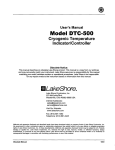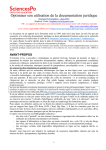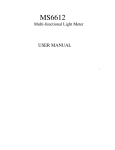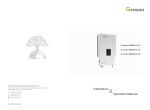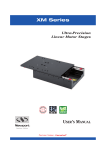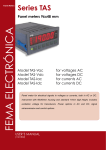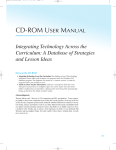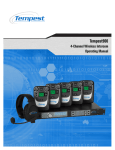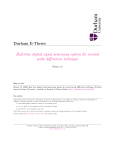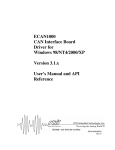Download LDS0400-T Laser Diffraction Sensor for Transparent - CERSA-MCI
Transcript
LDS0400-T Laser Diffraction Sensor for Transparent product User's manual. Manual version : 11.0.0 © 2012 CERSA-MCI CERSA-MCI 53, parc Expobat 13480 CABRIES FRANCE tel: +33 (0)4 42 02 60 44 fax: +33 (0)4 42 02 79 79 web: http://www.cersa-mci.com email: [email protected], [email protected] 2 Table of Contents Part I Introduction 4 Part II Specifications 5 1 General specifications ................................................................................................................................... 5 2 Mechanical ................................................................................................................................... design 6 Part III CIM software 8 Part IV Measures and principle 9 1 Generalities ................................................................................................................................... 9 1.1 1.2 1.3 Available measures ......................................................................................................................................................... 9 Events ......................................................................................................................................................... 9 Real time ......................................................................................................................................................... scopes 10 2 Diameter................................................................................................................................... 10 2.1 2.2 2.3 Optical principle ......................................................................................................................................................... Diffraction ......................................................................................................................................................... scope Real time ......................................................................................................................................................... diameter scope 10 11 11 3 Position ................................................................................................................................... and vibration 11 3.1 3.2 Part V Principle ......................................................................................................................................................... Vibration ......................................................................................................................................................... scope 11 12 13 Connexions and Interfaces 1 Digital I/O................................................................................................................................... 13 2 Length counting ................................................................................................................................... use 15 3 Serial link................................................................................................................................... 16 4 BNC Outputs ................................................................................................................................... 17 5 Front panel ................................................................................................................................... 17 6 External power ................................................................................................................................... supply 19 7 Air supply ................................................................................................................................... 19 Part VI 20 Instrument settings 1 Tolerances ................................................................................................................................... 20 2 Measure ................................................................................................................................... parameters 20 22 Part VII Installation on the line 1 Mounting................................................................................................................................... 22 2 Alignment ................................................................................................................................... 22 LDS0400-T user's manual Manual version : 11.0.0 Contents 3 Part VIII Maintenance, security and troubleshooting 23 1 Safety rules ................................................................................................................................... 23 2 Optical system ................................................................................................................................... cleaning 23 3 Error codes ................................................................................................................................... 24 Manual version : 11.0.0 4 Part I: Introduction Part I: Introduction The LDS0400-T (Laser Diffraction Sensor for Transparent products) is specially built for transparent products, such as optical fiber (glass or coated fiber). It measures the diameter in production towers. Its measurement principle is based on the laser diffraction. This method is fibre position and vibration independent. The LDS0400-T instrument uses the latest technology to give the maximum performance. Main Advantages · Accurate diameter measurement. · Fiber vibrations measurement independent. · Real time tolerances checking. · Fiber position and vibration measurement. · Spool length and speed computing. · Compact and hardened industrial instrument. · Local display of measures and parameters. CERSA-MCI develops and produces also complementary high performance measurement instruments for optical fiber production, at high drawing speed like: · LIS-G for Glass fiber diameter, spinning, non-circularity measurement and defect detection (including airline). · NCTM for Glass fiber drawing tension measurement. · CM-5 for Coated fiber diameter, Lump & Neck detection,internal defect detection and asymmetry measurement. LDS0400-T user's manual Manual version : 11.0.0 5 Part II: Specifications Part II: Specifications 1 General specifications Important: Instrument must absolutely be placed before any pulley or cabstan ABSOLUTE DIAMETER MEASUREMENT Range : 50-400 µm Uncertainty : ±0.15% of the diameter (limited to ±0,15µm) without averaging ±0.10% (averaged on BNC output) Remarks: Includes slow ambient temperature fluctuation within 10-35 °c. Includes fiber moves within 1.5mm radius circle Repeatability : ±0,07% of the diameter (limited to ±0,10µm) Measurement frequency : 400 Hz X & Y POSITION MEASUREMENT Range : ±2mm Uncertainty : ±0,1mm Measurement frequency : 1KHz VIBRATION FREQUENCY MEASUREMENT Using position measurement, the instrument computes by F.F.T.(Fast Fourier Transform) the vibration frequency which can be transferred to CIM software. BNC OUTPUTS Quantity : Voltage range : 4 ±10V DIGITAL OUTPUTS (Open collectors) For alarms, fiber defect, tolerances... Quantity : 8 DIGITAL INPUTS For length counting and length reset. Quantity : 2 RS232 COMMUNICATION Used to connect the instrument to CIM software Baudrate : 115200 Maximum cable length : 35 meters (certified only with cables supplied by CERSA) ENVIRONMENTAL CONDITIONS: Air flow of 5 to 20 litters per minute required to clean the optics and cool down the electronic. Ambient working temperature : Maximal working internal temperature : Storage temperature : 10 - 35 °c 55 °c 0 - 60 °c Manual version : 11.0.0 6 Part II: Specifications 2 Mechanical design · Weight: LDS0400-T user's manual 4,7 kg Manual version : 11.0.0 7 Part II: Specifications · Weight of the external supply: 300g. Manual version : 11.0.0 8 Part III: CIM software Part III: CIM software C.I.M. software (CERSA Instruments Manager) is a new PC environment that manage all CERSA-MCI instruments. It provides a complete set of comprehensive tools to improve and master the production process as well as all features to certify the whole production specifications in line. Main features : · Monitoring the process in real time. · Data logging (database). · Production reports. · Instruments configuration. Acces level : 2 access level are defined: user and supervisor. · The supervisor level has no restriction. · The user level is limited to the basic operator use, some advanced configuration are disable. LDS0400-T user's manual Manual version : 11.0.0 9 Part IV: Measures and principle Part IV: Measures and principle 1 Generalities 1.1 Available measures Here below is the list of measures transferred from the instrument to CIM. Measure unit Description access level Diameter [µm] Value of the outer diameter. user Speed mmin [m/min] Value of the production speed. user Speed ms [m/s] Value of the production speed. user Temp. [°C] Value of internal temperature of the instrument. Should not supervisor exceed 55°. Vibration [Hz] Value of the vibration frequency of the measured object. user X position [mm] Value of the X position for the measured object. user Y position [mm] Value of the Y position for the measured object. user Remark: A non-measured value is forced to zero, except for X & Y positions which are force to 5.00mm 1.2 Events It is a particular phenomenon that is detected by the instrument. Events are detected in real time, dated (3ms accuracy) and located (fiber length). Each event is also characterized by its extremum value. Here below is an example of high speed diameter fluctuation which exceeds the tolerances. Here below is the list of events transferred from the instrument to CIM: Event unit Description Diameter Status [µm] Diameter event is generated in case of out of tolerances. General status of the instrument. access level user user Manual version : 11.0.0 10 Part IV: Measures and principle 1.3 Real time scopes Because the measurement frequency of the instrument is very high, it is impossible to transfer all measures in real time to the computer through RS232. The instrument stores the main measures continuously in internal buffers of 500 points each . This function is called Real Time Scope. Those buffers can be watched through CIM. Only few buffers per seconds can be watched, because of communication constraints. The sampling period of each buffer can be modified, depending on the time scale you want to analyse. Those tools are very useful for process analysis to qualify the stability, the regulation performance, and display some particular effects. The F.F.T. processing shows specific oscillations. We recommend strongly to the process engineer to use those tools for understanding and improvement of the manufacturing process. 2 Diameter 2.1 Optical principle The light ray deviation due to a material tangential effect creates a diffraction phenomenon. When a fiber is placed in a collimated light source, two symmetrical effects appear on each side of any fiber diameter, like two new sources of coherent light, producing interferometric fringes perpendicular to the fiber. The period of the fringes is a direct function of the fiber diameter . An optical system concentrates the fringe signal on a linear CCD sensor. Due both to the phenomenon and to the optical system, the sensor signal is fiber position independent. The fringe signal comes from the angular deviation of the rays. All the parallel rays from the laser source are focused on the center of the CCD where the optical mask is placed. All the rays deviated by the fiber, reflection and diffraction, in the same angular direction are focused at the same position on the CCD sensor. Thus when the fiber moves or vibrates, the fringe signal does not change. LDS0400-T user's manual Manual version : 11.0.0 11 Part IV: Measures and principle 2.2 Diffraction scope This scope shows 1 signal: · CCD diffraction axis 1: Light energy vs pixel. It shows the signal acquired by the CCD. This scope is used for maintenance purpose to check the signal quality. Results displayed in the scope: · Diameter: the diameter measure corresponding to the displayed signal. · Status: the alarm code corresponding to the displayed signal. · Amplitude: the fringes amplitude. This value should be around 30-40 for 245µm fiber, otherwise the instrument is not good conditions for measurement. 2.3 Real time diameter scope This scope shows 1 signal: · Real time diameter diffraction: Diameter vs time. It shows real time diameter fluctuations. This scope is interesting for process study and analysis. It can show high speed phenomenon, such as spinning or diameter oscillations. The following parameter can be adjusted: · Sampling period [ms]: Represents the duration between 2 storages inside the buffer. It is used to adapt the time scale. Minimum value: 2.500ms. 3 Position and vibration 3.1 Principle Fiber position is measured by 2 position sensors: X and Y. Those 2 PSD (Position sensitive detectors) analyse the light diffused by the fiber and provide an accuracy of +/-0.1mm. The measurement range is limited to +/-2.0mm on both sensors. The vibration frequency measurement comes from the spectrum analysis of the Y position signal (more sensitive than X). It can be measured only if oscillations are stable and large enough. Manual version : 11.0.0 12 Part IV: Measures and principle 3.2 Vibration scope This scope shows 2 signals: · F.F.T. of the Y position: Energy vs frequency. It shows the normalized Fast Fourier Transform of the Y position signal.. · Y postion signal: Y axis position vs time. It shows fiber position measured by the Y position sensor. This scope is interesting for vibration analysis. When the instrument is placed between the furnace and the first coating die, it can display the natural fiber vibration which is an image of the drawing tension. Results displayed in the scope: · F.F.T. DC energy: represents the F.F.T. level of the DC part (Frequency = 0Hz) · F.F.T. peak energy: represents the F.F.T. level of the main peak. · Frequency [Hz]: the vibration frequency value of the detected F.F.T. peak. The following parameters can be adjusted: · Sampling period [ms]: Represent the duration between 2 storages inside the buffer. It is used to adapt the time scale. Minimum value: 1.000ms. · Min window [Hz]: The minimum frequency used to search for a F.F.T. peak. · Max window [Hz]: The maximum frequency used to search for a F.F.T. peak. · Min peak energy: The minimum energy to be considered as a peak. · Min peak level: The minimum normalized peak level to be considered as a peak. · Max peak width[Hz]: If a peak is detected, its width (referring to the min peak level) should not exceed the max peak width to be considered as a real peak. LDS0400-T user's manual Manual version : 11.0.0 13 Part V: Connexions and Interfaces Part V: Connexions and Interfaces Here below is the rear face of the instruments: 1 Digital I/O IN/OUT connector is a SUB-D 15 pins. It is used for alarms and external controls. · 8 Outputs (open collectors 60 VCC max, 24 or 48 standard DC voltages) with common ground. · 2 floating opto-isolated Inputs with common anode designed for 24V DC for open collectors. Other voltages on demand (Internal resistors have to be adapted). Manual version : 11.0.0 14 Part V: Connexions and Interfaces DB15 I/O type I/O name Pin Number 1 Input SPOOL RESET 9 Input 2 10 3 11 4 12 5 13 6 14 7 15 8 Output LENGTH COUNTING POSITION OUT Output NOT USED Description Reset fiber length. Fiber length counting pulses. Fiber position is out of 1.5mm circle radius. Measures are not certified. BNC outputs are forced to a fixed voltage. Referen 24VIN ce User’s DC external voltage for inputs (V+) Output LOW Diameter < Low tolerance Output HIGH Diameter > High tolerance Output NOT USED Output RUN Output NOT USED Output NOT USED Output NOT USED Instrument is running (power is on) Referen CLAMP ce Diode protection input when one relay is monitored Referen GND ce Voltage ground reference for 24VIN and outputs Referen GND ce Voltage ground reference for 24VIN and outputs Output states: · When the output is activated (example: Fiber position is out), the collector is open. · When the output is not activated (example: Fiber position is correct), the collector is closed. Input states: · To activate the input (example: to reset the length), you must force the potential of the input from 24VIN to GND. · To deactivate the input, you must release the potential of the input (internal pull-up to 24VIN) or force it to 24VIN. LDS0400-T user's manual Manual version : 11.0.0 15 Part V: Connexions and Interfaces Remark: · Lamp, Load and Relay are shown as user application examples. 2 Length counting use If you connect the length counting signal and the reset signal, the instrument will compute the speed and length with the same reference as your production system. It permits the instrument to locate accurately all events in the spool. It can help you to determine the portion of product to reject. Manual version : 11.0.0 16 Part V: Connexions and Interfaces The length counting interface has to be configured under CIM software (Parameters manager / Digital interface) with the following parameters: Pulses number: The number of pulses for 1 meter length. Slip factor: in case of the real speed and the measured speed are not perfectly correlated, you can adjust this factor. This multiplication factor is applied to the measured speed. Default value: 1.0 Remark: Those parameters are accessible in CIM software in Parameters manager / Digital interface tab. 3 Serial link The dedicated pins of the serial link SUB-D9 pins connector of the instrument are: DB9 Pins nb. 1 6 2 7 3 8 4 9 5 IN/OUT Signal connect to PC DB9 Pins nb. OUT IN IN OUT TXD: Data out CTS: Clear to send RXD: Data in RTS: Ready to send 2 (RxD) 7 (RTS) 3 (TxD) 8 (CTS) GND: voltage ground ref 5 (GND) The cable to use is a standard straight RS232 cable (pin to pin) . It must be shielded. CERSA provides on demand 15, 25 or 35 meters certified cables. Communication settings: · baudrate: 115200 bauds · data bits: 8 · parity: even · stop bit: 1 LDS0400-T user's manual Manual version : 11.0.0 17 Part V: Connexions and Interfaces 4 BNC Outputs Specifications: · · · · Voltage range: Accuracy: Minimum resistive load: Maximum capacitive load: ±10V ±50mV 10kW with short circuit protection. 100pF Here below is the measurement type provided on each BNC. BNC 1 Accurate diameter output BNC 2 X position output BNC 3 Y position output BNC 4 Large scale diameter output Remarks: · Output voltage is limited from -10 V to +10 V. · Output scales are adjustable with the following parameters under CIM software (Parameters manager /Analog interface): Zero point: When the measured value reaches the zero point value, the corresponding analogical output is set to 0V. The unit of the zero point is the same as the corresponding measure. Scale: Is the number of volts per measure unit. For example for position in millimeters 2 [V/ mm]: if the measure varies of 1mm the value of analog output varies of 2 Volt. Regulation: If this option is activated, then the zero point value is automatically forced to the nominal tolerance value of the corresponding measure. Otherwise the zero point can have any value. Average time: Is the average time used to compute the analog output signal. 5 Front panel A back lighted LCD displays the different parameters available locally. It is controlled by two push buttons. SCREEN: will change type of information to display. CHANGE: is used to modify the settings. Manual version : 11.0.0 18 Part V: Connexions and Interfaces At start up, the screen displays the instrument serial number and last embedded software version. By pushing on SCREEN button, you can display the following information: This screen displays Diameter, X position and Y position This screen displays the produced Length and the Speed. By pushing on CHANGE button, you will reset the length to zero. This screen displays the internal Temperature. Remark: You can reset the instrument (load factory data), you must push SCREEN and CHANGE buttons together just after powering-up the instrument. LDS0400-T user's manual Manual version : 11.0.0 19 Part V: Connexions and Interfaces 6 External power supply The instrument comes with its CERSA MCI’s power supply. This power supply provides +12V volts rectified and filtered DC voltage with a power of 45W as well as ground protection continuity. An short-circuit protection is included. Input voltage : from 100V to 240V AC, 50 to 60 Hz. 7 Air supply A standard connector for 6mm PVC air pipe is included on the rear panel. The air exit inside the lens mechanical protection. A clean and dry air flow of 5 to 20 litters per minute is required to clean the optics and cool down the electronic.. The air supply is absolutely needed for cooling down. The instrument can be damaged if the air is not connected to the instrument (internal overheat). It has also the interest to avoid dust to deposit on the lenses. Manual version : 11.0.0 20 Part VI: Instrument settings Part VI: Instrument settings A full set of parameters can be adjusted using CIM software. Remark: All parameters are stored and saved in a embedded EEPROM. 1 Tolerances The instrument monitors in real time if the measures are in or out of the product tolerances. In case of tolerance defect, the instrument will act as follow: · Digital output state will change. Refer to the Digital I/O chapter. · Data are transferred to CIM which will show events with full details about dating, positioning and extremum values. Here below is the logic used for tolerance control: Measure > Nominal tolerance + Warning high tolerance Measure < Nominal tolerance - Warning low tolerance Measure > Nominal tolerance + Out high tolerance Measure < Nominal tolerance - Out low tolerance EVENT WARNING HIGH (Not yet available) EVENT WARNING LOW (Not yet available) EVENT OUT HIGH EVENT OUT LOW Here below is the full list of tolerances parameters that can be adjusted with CIM software ( Parameters manager /Tolerances): Parameter unit Description access level Avg. time diameter [ms] Nominal diameter Out high diameter Out low diameter Warning high diameter Warning low diameter [µm] [µm] [µm] [µm] [µm] Time during which the diameter will be averaged to supervisor compute out of tolerances. (enter zero to disable) Nominal diameter value. user Maximum diameter tolerance. (enter zero to disable) user Minimum diameter tolerance. (enter zero to disable) user Maximum diameter warning tolerance. (enter zero to user disable) Minimum diameter warning tolerance. (enter zero to user disable) 2 Measure parameters Here below is the full list of measures parameters that can be adjusted with CIM software( Parameters manager /Measures): Parameter unit Description access level Avg. time display [ms] Averaging time of the diameter measure shown on the supervisor diam. local display and transferred to CIM. Diameter offset [µm] Offset applied on the diameter value. It can be used to supervisor correct the calibration of the instrument. Pos. out ana. val. [V] In case of position out, the voltage value to apply on all supervisor BNC. Pos. out tempo [s] If the object to measure leaves the measurement area supervisor during this time, it is considered as position out. All LDS0400-T user's manual Manual version : 11.0.0 21 Part VI: Instrument settings measures are forced to init value. Remark about diffraction diameter calibration: Thanks to the optical system and measurement principle, you should not modify the offset value (default value: 0). In case of you really need to correct the measure, you have to follow this procedure: 1. Wait for the temperature stabilization for at least 1 hour. 2. Be sure of the cleanness of the optical system. 3. You must have a standard fiber or metallic wire. The standard has to be very circular (noncircularity less than 0.2µm) and must be measured by an external accurate offline measurement system. 4. Clean perfectly this standard with IPA(IsoPropylic Alcohol). 5. Place this standard (without touching the part which will be measured) in the center of the LIS. Be sure that the standard position is around 0.0mm (+/- 0.2mm). 6. Enter the value of your standard, it will calibrate instantaneously your instrument. Manual version : 11.0.0 22 Part VII: Installation on the line Part VII: Installation on the line 1 Mounting You do not need any fine adjustable support. A single horizontal metal plate, 3 mm thick, with 4x Æ4.20mm holes would be sufficient. You must reserve the possibility of a manual adjustment to adjust the position of the instrument on the fiber axis. In case of the instrument is used for bare fiber, pay attention to the following: · To have the best regulation response, the instrument has to be near the furnace (2m to 5m). · Because the glass fiber is a important heating source, the internal temperature must be checked (55 degrees maximum) with CIM software during fiber drawing, especially at the highest production speed. Remark: · At very high production speed the fiber itself becomes an important heating source. · Air supply is necessary to maintain the internal temperature and ensure the behavior of electronic devices. Refer to Air supply chapter. 2 Alignment All measures are independent of the fibre position while the fibre stays within 1.5mm radius. We recommend to keep the fiber within a 1.0mm circle radius. Out of a 1.5mm circle radius, the measurement is not possible. LDS0400-T user's manual Manual version : 11.0.0 Part VIII: Maintenance, security and troubleshooting 23 Part VIII: Maintenance, security and troubleshooting 1 Safety rules There is no particular protection constraint for users in the case of a normal operation of the devices. Laser source information: The laser is not directly visible if you keep mounted the black cover. Class 1 laser device according to the classifications given by the "The Food Administration" of the United-States, document FDA 81-8140, section 1040-10. 2 Optical system cleaning The lenses cleaning should be performed regularly depending on the environment. In most of the cases, a simple dry air blowing action each month into the lenses protection is sufficient. The user must remember that dust on the lenses degrades the device’s accuracy. To clean the lenses, please follow this procedure: 1. Unplug the power supply. 2. Remove the top black cover (you must first remove the screw). 3. Use dry air to eliminate the biggest particles. 4. Use cotton or dry tissue with IPA (IsoPropylic Alcohol) and clean carefully each dirty lens. 5. Check visually the surface of the lenses. 6. Replace the cover and tight the screw. Manual version : 11.0.0 24 Part VIII: Maintenance, security and troubleshooting 3 Error codes In case of measurement problem or error, the instrument will show on the local display an error code. This code is also transferred to CIM which will display a short text. For further details about these codes, please refer to the following table: Error code Text displayed in CIM value 11 WARNING HIGH 8 WARNING LOW 5 OUT HIGH 2 OUT LOW 0 OK -1 RESET SPOOL -2 EVENT MAX -3 ANA END SET -4 ANA START SET -5 ANA OUT -6 DRIFT -7 SPINNING INIT -8 INT. EMPTY -9 INT. LOST -10 DIFF. ERR. -11 SPINNING ADAPT -12 ASYM NUM ERR. -13 DIAM NUM ERR. -14 RS232 ERR. -100 LOCKED -200 HIGH TEMP -201 SOURCE -202 UNST TEMP -203 CCD -204 EEPROM -205 MCBSP C32 -206 MCBSP FO -207 ECAN FO -208 CCD READ INT -209 HW VER. INC. -300 POSITION OUT -301 WRONG POSITION -400 SIGNAL LOW -401 SIGNAL SATURATE -402 SIGNAL DIRTY -403 SIGNAL OUTRANGE -499 SIGNAL -501 ALGO ASYMETRY -502 ALGO MINMAX -503 ALGO PERIOD -504 ALGO ZERO -505 ALGO CALCUL -506 ALGO NBFRINGES -507 ALGO NOFRINGE LDS0400-T user's manual Description Tolerance current state warning high Tolerance current state warning low Tolerance current state out high Tolerance current state out low Status is OK Indicates a spool length reset event CERSA Internal event CERSA Internal event CERSA Internal event CERSA Internal event CERSA Internal event CERSA Internal event CERSA Internal event CERSA Internal event Diffraction measurement error CERSA Internal event Asymmetry measurement error Diameter measurement error RS232 communication error Measure is locked. Temperature is too high Source regulation problem Temperature is not stable CCD sensor error CERSA Internal event CERSA Internal event CERSA Internal event CERSA Internal event CERSA Internal event CERSA Internal event Fiber position is out of the measurement area Fiber position is not correct Signal is not correct for analyse Signal is not correct for analyse Signal is not correct for analyse Signal is not correct for analyse Signal is not correct for analyse Signal is not correct for analyse Signal is not correct for analyse Signal is not correct for analyse Signal is not correct for analyse Signal is not correct for analyse Signal is not correct for analyse Signal is not correct for analyse Manual version : 11.0.0 Part VIII: Maintenance, security and troubleshooting Error code Text displayed in CIM value -508 ALGO ZEROSIDE -509 ALGO ASYNC -599 ALGO Description Signal is not correct for analyse Signal is not correct for analyse Signal is not correct for analyse Manual version : 11.0.0 25



























